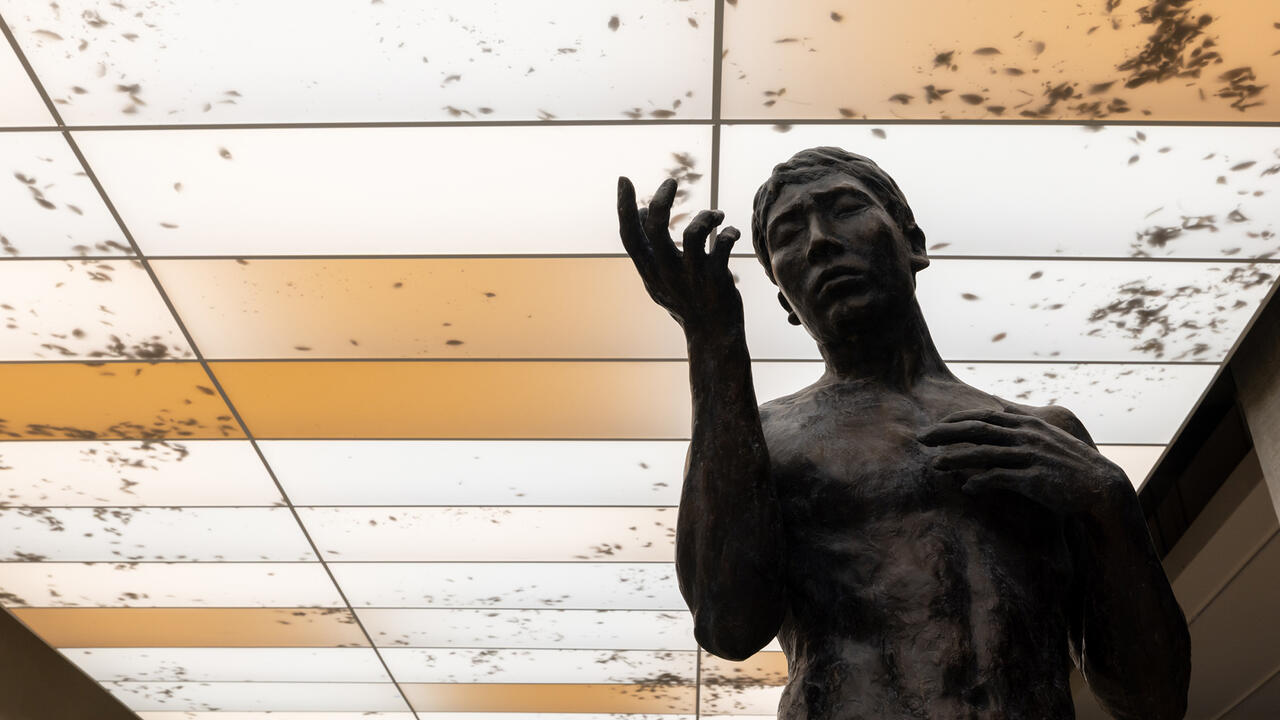Nina Beier
Laura Bartlett Gallery
Laura Bartlett Gallery

In Nina Beier’s sparse and considered work, absence is a smoking gun. The Broken Ear Restored (all works 2010) is a cut-up poster of the eponymous 1937 Tintin book; it is also the key that unlocks the artist’s underlying interest in fragmentation, lost origins and ersatz decoys. In Hergé’s The Broken Ear, an idol is stolen from the Museum of Ethnography in Brussels and replaced, in a rather half-hearted switcheroo, with a fake. This is spotted almost immediately by Tintin, who realizes that while the ear of the original was shattered, the replacement is intact (incompleteness being a sign of authenticity) – this, in turn, leads to further adventures as our hero searches for the genuine idol in the jungles of South America. Like so many stories about lost lovers and stolen goods, The Broken Ear spins around a vacant core, as water circles a plughole.
In Beier’s practice, a similar eddying is at work. Dust Painting looks like the remains of a spontaneous combustion: a scattering of powder on the gallery floor that we might assume is (as the title suggests) a mound of dust, or if we were to take the title literally, a painting of a pile of dust. It’s a neat double bluff: it is in fact, a pile of dust-coloured paint. Beier’s approach frequently appears both literal and jocular, but it’s trickier than that. For example, in the two framed posters that give this exhibition its name, What Follows Will Follow, both of which depict bodily fragments of sculptures (a foot on a pedestal, and the flame wielding hand of the Statue of Liberty), the connections between missing-whole and present-part are connected to the classical world. It’s no surprise then that Beier’s work toys playfully with the cliché of material essence, whose roots go back to ancient Greece (think of the notions of mimesis and ekphrasis, for example) – ideas that suggest that every object has a sort of spiritual magnetism that binds it together, even after it has been dismembered and disfigured.
Another way of reading Beier’s work is to say that it performs a sort of artistic striptease, in which layers are removed slowly for the sake of pleasure rather than truth (contrast this with the strip-search of early Conceptualists). This is most obvious in the ‘Portrait’ series: five picture-frames containing the clothes worn by Malte Seibt, a Berlin-based picture framer, on the day that he made the frames. The clothes that he has selected seem particularly well considered: each is a monochrome dark blue that only on closer inspection reveals its identity as a T-shirt, a jacket, a shirt, socks and jeans. There’s an odd mixture here of generosity in denying the artist’s own authorial imprint, and meanness in the appropriation of the workman’s clothes. If these images are a cumulative portrait, they’re also an almost tender form of theft.
Dwelling on hoary old ideas of authorship, artistic genesis and agency can certainly be fun. It can also be rather wearying, as in the ‘Collected Works’ series, in which re-presented cuttings from Beier’s own practice are trapped beneath brown UV filters. More interesting is ‘Closing Argument’, a series of posters from exhibitions at various European art galleries and museums for artists from Arne Ungermann to Picasso, which are trapped beneath sandblasted glass so they’re not quite legible. The posters are proof of the fleeting nature of art and the exhibition as an event. If this temporality needs further reinforcement it’s given in the print-on-demand posters that the artist has cropped and framed in What Follows Will Follow: the works are themselves part of an ‘indefinite edition’ that will continue for as long as the commercial service is offered. If narratives are attempts to fill in voids, we might say that Beier’s interest in prolonging the event of incompleteness is a means of evacuating herself from the plot.
























